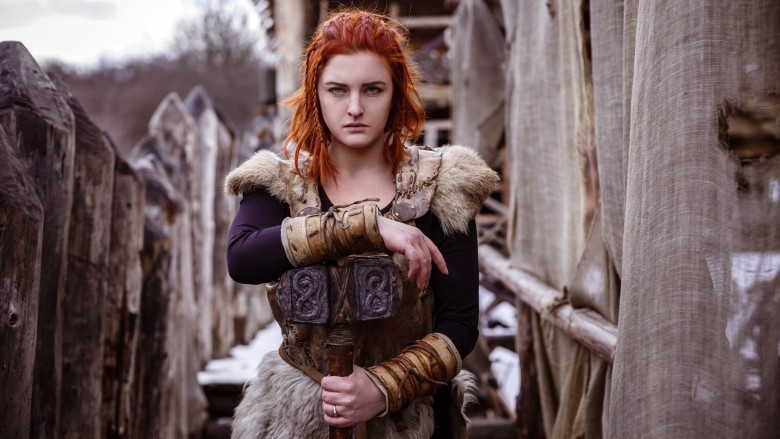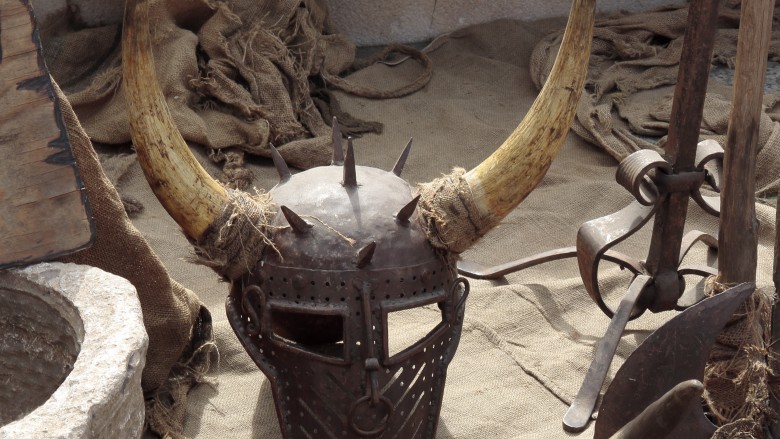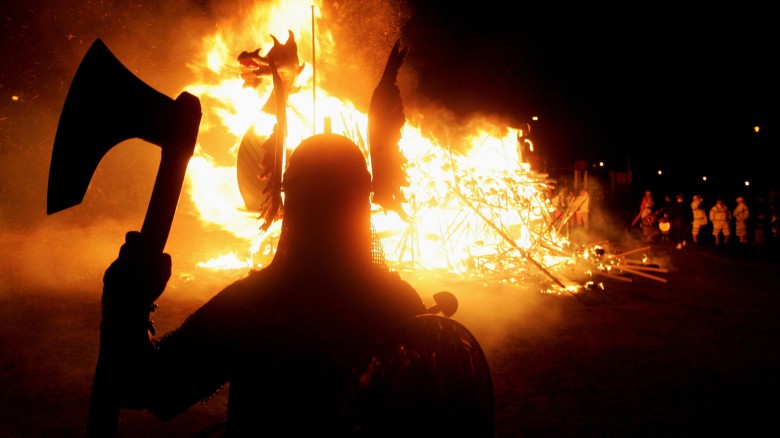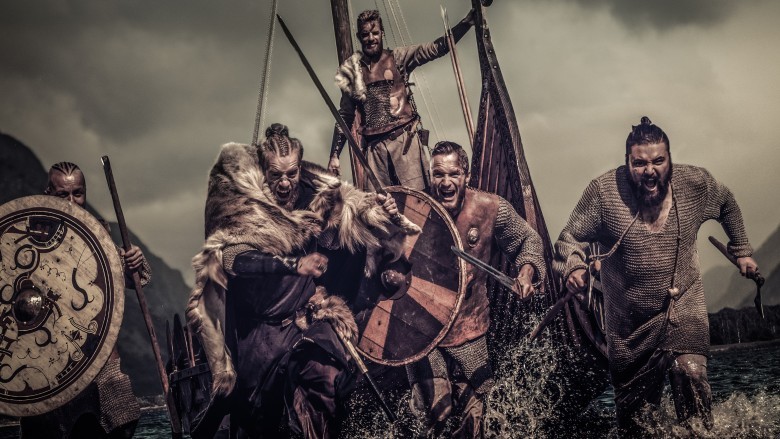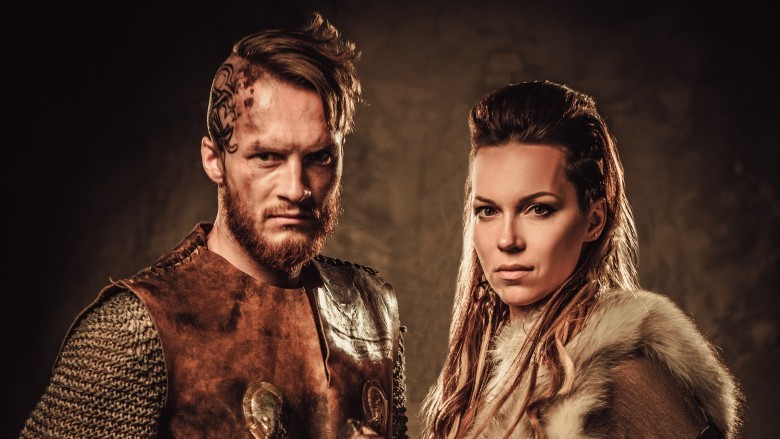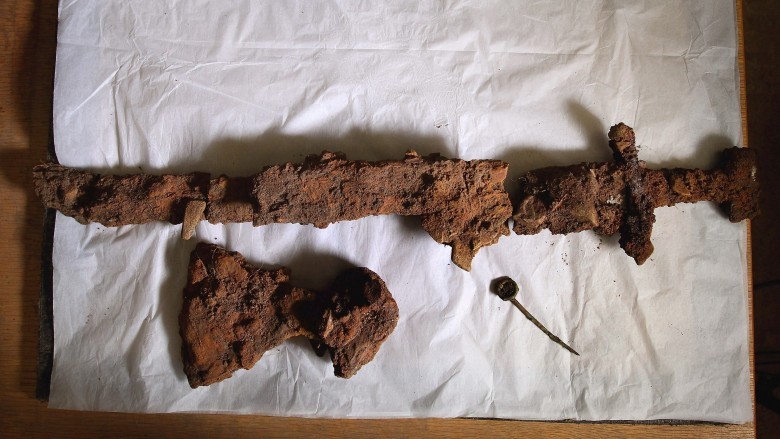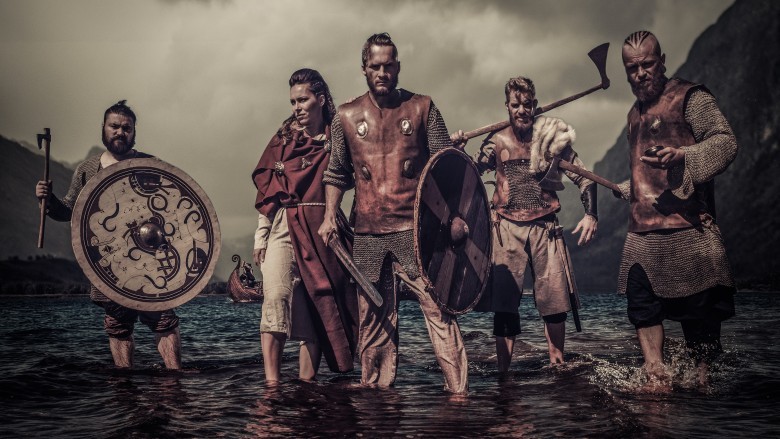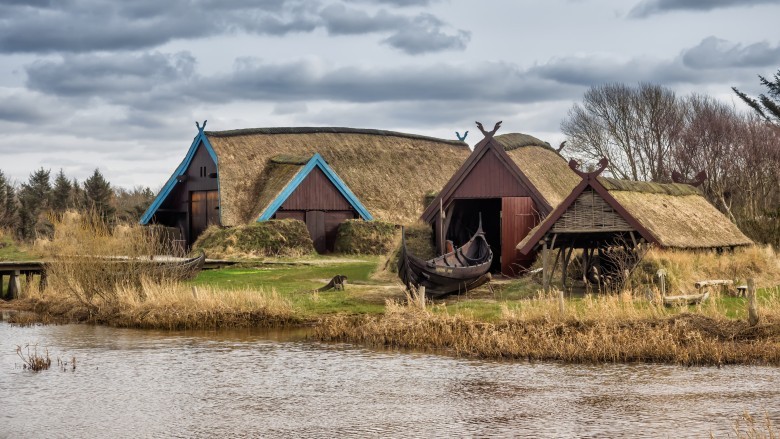False Facts About Vikings Everyone Thinks Are True
Imagine sitting in your ninth-century village, watching as some hostile longships make their way toward shore. You've heard of these brutal pagans. Everyone's heard of these brutal pagans! It's the Vikings, coming to plunder your village, defile your church, and enslave some villagers.
Not a particularly pleasant situation for anyone to be in, that's for sure, as the Vikings certainly terrorized the many lands they explored. But who were these Norse pirates, really? What did they look like? What kinds of weapons did they use, and what exactly did they do? For centuries, there's been a lot of false information about these seafaring folk, riding the waves of our imagination and creating images at odds with historical reality.
They wore horned helmets
When you think of Vikings, you think of horned helmets. Don't even act like you don't. It's ingrained in our mind, thanks in part to the National Football League's Minnesota Vikings and their iconic helmet design, as well as the long-running Hägar the Horrible comic strip. However, the Vikings did not, in fact, wear horned helmets ... though other people did.
The origin of the horned helmet–sporting Viking goes back to fin-de-siecle Europe, or a bit earlier, to legendary composer, conductor, and theatre director Richard Wagner. The German opera man wrote his epic, Norse-inspired Der Ring des Nibelungen in 1876, in which costume designer Carl Emil Doepler decided to stick some horns on his epically badass—at least for the opera—outfits, thus spawning the myth that Vikings wore horned helmets.
Though the Vikings may not have sported horns on their headgear, others did—including the warriors of ancient German mythos. According to Vox, late-19th-century Germans—well into nationalism already, by this point—found Viking history appealing, "in part because they represented a classical origin story free from Greek and Roman baggage." So, thanks to Doepler, "stereotypical ancient and medieval German headdresses—like horned helmets" were melded together with Viking imagery, and thus "Norse and German legends were intertwined in the popular imagination, and we still haven't untangled them."
In other words, we can all blame the Germans for lying to us about Vikings and their horned helmets. Furthermore, horned helmets wouldn't have been particularly protective in close combat, as they'd allow the enemy to more easily snap your neck. The Vikings were probably more clever than that. But the hats still look badass.
All they did was rape and pillage
We all know what the Vikings did best. They showed up in England on June 8, 793 and began roughly 300 years full of violence, brutality, raping, and pillaging. Just because this is what the Vikings are known for, however, doesn't mean that's all they did.
That being said, we definitely shouldn't pretend the Vikings weren't brutal. Says Simon Keynes, an Anglo-Saxon historian at Cambridge University, "There's no question how nasty, unpleasant, and brutish they were. They did all that the Vikings were reputed to have done." According to Keynes, they stole everything they could get their hands on. They looted and defiled churches, carried off women, burned down settlements, and kept coming back for more. They were, indeed, quite cruel. Still, there was more to these marauding invaders than meets the eye.
For starters, the Vikings didn't always just take what they wanted. Sometimes, they traded goods with the people they came in contact with. According to James Montgomery, professor of Arabic at Cambridge University, the Vikings' contact with the Khazar empire, expeditions to Baghdad, and contribution to the formation of Kiev allow for a reevaluation of the violent Viking stereotype. With recent scholarship, it becomes easier to view some Vikings as global traders. They also clearly had a penchant for storytelling, with the Norse sagas sometimes being likened to the world's first soap operas. And while many Vikings raped and pillaged, so too did many stay behind, settle, assimilate, and influence culture—with many accepting and embracing Christianity. In fact, according to Chris Tuckley, head of interpretation at the Jorvik Center, the Vikings weren't nearly as bad as the Normans, who systematically "oppressed the local populace rather than integrating as the Vikings did."
Still, the image of Vikings as marauding and terrorizing raiders makes for more engaging movies. Nobody really wants to watch a bunch of Norsemen farming, after all.
They were more bloodthirsty than their contemporaries
Along with the imagery of Vikings as rapists and pillagers comes the view that they were exceptionally bloodthirsty—much more so than the poor people they terrorized. History, however, proves this isn't really the case.
Contrary to what some might foolishly believe, the world was not a particularly peaceful place until the Vikings showed up and despoiled paradise. Eleven years before the Vikings showed up in Lindisfarne, Charlemagne committed a brutal war crime in Lower Saxony, Germany. Known as the Massacre of Verden, Charlemagne ordered the beheading of some 4,500 Saxons, effectively eradicating their tribal leadership and forcing them to become subjects of Frankish authorities—exhibiting a level of systematic brutality well above any showed by the Vikings. And, according to BBC, the Anglo-Saxons didn't necessarily take the high road against their heathen enemies, noting, "the Anglo-Saxons were hardly upholders of a prototype Geneva Convention. In 2010 it was reported that 50 decapitated bodies had been found in Weymouth, thought to be executed Viking captives."
The Vikings may have been great warriors and brutal to their victims, sure, but history is a long and bloody subject, with the Vikings merely occupying a one violent stage, sandwiched between other violent chapters.
They were dirty
The Vikings may have enjoyed raping, pillaging, and busting open skulls with axes while under the influence of psychedelic mushrooms—but they liked to look fresh to def while doing it.
According to The Telegraph, Cambridge University scholars are convinced the Vikings were all about that personal hygiene. In fact, the Danes were almost too clean, according to medieval chronicler John of Wallingford, who alleged that they combed their hair every day, bathed once a week, and even went so far as to change their clothes on a regular basis. Furthermore, the Vikings' baggy pants were apparently all the rage, raising the stylistic bar and being cool enough to make even '90s high schoolers jealous.
Carolyn Emerick argues that the Vikings were totally "metrosexual," exhibiting a penchant for grooming and style, with hairstyle being especially important to Viking men. Emerick even claims the Vikings bleached their hair and beards blonde, while—like a college sophomore showing off in the quad—also enjoying some good poetry and conversations about love. The National Museum of Denmark has evidence that Vikings used well-designed combs, toothpicks, ear picks, and tweezers—in addition to both sexes sporting some serious makeup—with the men having little lady-trouble abroad.
So the next time you're watching Ragnar Lothbrok and Lagertha slay some Saxons, you can rest assured that they probably did look that cool while doing it.
They drank from skulls
As badass as it is to imagine Vikings drinking blood or mead from the skulls of their defeated enemies, this classic image of the barbarian Viking is simply untrue.
Like much throughout history, the truth of this myth seems to have gotten lost in translation. According to Heather O'Donoghue's English Poetry and Old Norse Myth: A History, "The celebrated image of Vikings drinking from cups made from the skulls of their enemies arose from a misunderstanding of a kenning in the Death Song." More specifically, O'Donoghue writes that the translator in question, Ole Worm, "seems to have mistaken a kenning for drinking horns, "the curved trees of skulls," as denoting skulls themselves, explaining in a Latin note that the verse depicts warriors drinking "ex craniis eorum quos occiderant." Damn it, Ole Worm!
In reality, Vikings drank from more boring utensils, like wooden and metal cups—though there's sufficient evidence to suggest that they did, in fact, drink from a good goat or cow horn every now and again. And should one be lucky enough to enter Valhalla, they might be offered a horn of mead from a Valkyrie.
Their weapons were crude
Along with other misconceptions, the stereotypical image of a Viking is a warrior carrying a fairly primitive battle-ax, club, sword, or something not particularly well crafted. Viking enthusiasts, fear not—the Nordic people sported some fine pieces of weaponry that were anything but dull.
According to BBC, all free Viking men were expected to carry weapons—like some romantic, Norse-version of the Wild West—and wealthy magnates were required to provide weapons to their men. They wielded finely crafted spears, swords, and battle-axes, often decorated with inlays and precious metals, such as silver, copper, and bronze. Spears were the most common weapon, though some more privileged Vikings had swords with personalized hilts and names, such as Leg-biter and Gold-hilt.
The famed Viking battle-ax was indeed used, though at the disadvantage of not being able to hold a shield—thus forcing those favoring the massive axe to wait behind a wall of shield-bearers, only able to strike at the opportune moment. Their shields were wooden, heavy, and effective, and some warriors were likely decked out in leather armor made from reindeer hide, said to be even more effective than the rare chain-mail armor possibly worn by leaders or more important individuals. Furthermore, helmets were, in all likelihood, not used at all, as they'd have been too expensive and required too much skill to make.
Though their weapons may have been a step behind some of those used by the Saxons or the Franks, Viking weaponry was still badass enough to strike fear—or blades—into the hearts of their enemies.
They were one people
Most people tend to view Vikings as one people, or as a homogenous race of human beings, but this isn't really true.
According to the History Channel, the Vikings were not a race of people, nor were they "linked by ties of common ancestry or patriotism, and could not be defined by any particular sense of 'Viking-ness.' Most of the Vikings whose activities are best known come from the areas now known as Denmark, Norway, and Sweden, though there are mentions in historical records of Finnish, Estonian and Saami Vikings as well." The only thing that these various Vikings had in common was that they were foreign, weren't civilized by European standards, and—most importantly—were definitely not Christian.
In reality, the Vikings probably didn't even refer to themselves as Vikings, as the word itself simply refers to someone who went raiding or exploring overseas. The lands comprising modern-day Denmark, Norway, and Sweden were not unified, and tribes were certainly not strangers to battling each other for land and power. Though it might not be the best literal translation, calling someone a Viking would have been akin to calling them a Scandinavian explorer, or pirate, or raider—not so much who they are, but what they do.
But, for the sake of ease, let's just keep referring to them all as Vikings, shall we? It's just so much easier than differentiating between Danes and Geats and Goths and Icelanders. Nobody's got time for that.
They all lived in Scandinavia
You may be forgiven for thinking that all Vikings lived in Scandinavia, as they certainly seemed to originate from there. However, contrary to popular belief, Vikings established settlements in all directions—assimilating, influencing, and shaping a variety of non-Scandinavian cultures.
The so-called Viking Age is said to have lasted roughly 300 years, and in this time, they certainly did more than merely raid. There should be little doubt that many individuals chose to stay in their newly discovered lands, influencing said cultures. In addition to England, Vikings made their way to modern-day Newfoundland, France, Germany, Ukraine, Russia, central Asia, and the Middle-East, leaving at least some sort of mark in each of these places—from Baghdad to Kiev. Some Viking settlers bought what Christianity was selling, and there was surely a fair amount of intermarriage. According to BBC, King Cnut was the king of England for 25 years, bringing in Norse influence without putting a stop to regular English life.
Sure, loads of Vikings went back to their homelands, only to raid and pillage more later. Many, however, were surely interested in the opportunity to start a new life in a new land, and influential settlements speckled the landscapes the Norsemen visited. It's always good to have friends or relatives in foreign countries, so you have a place to crash after a night of pillaging and looting.
